Summary
Rev Bras Ginecol Obstet. 2024;46:e-rbgo22
RhD alloimmunization in pregnancy is still the main cause of hemolytic disease of the fetus and neonate (HDFN). Nevertheless, there are other antigens that may be associated with the occurrence of this phenomenon and that have been growing in proportion, given that current prevention strategies focus only on anti-RhD antibodies. Although not widespread, the screening and diagnostic management of the disease caused by these antibodies has recommendations in the literature. For this reason, the following review was carried out with the objective of listing the main red blood cell antigen groups described — such as Rh, ABO, Kell, MNS, Duffy, Kidd, among others — addressing the clinical importance of each one, prevalence in different countries, and recommended management when detecting such antibodies during pregnancy.
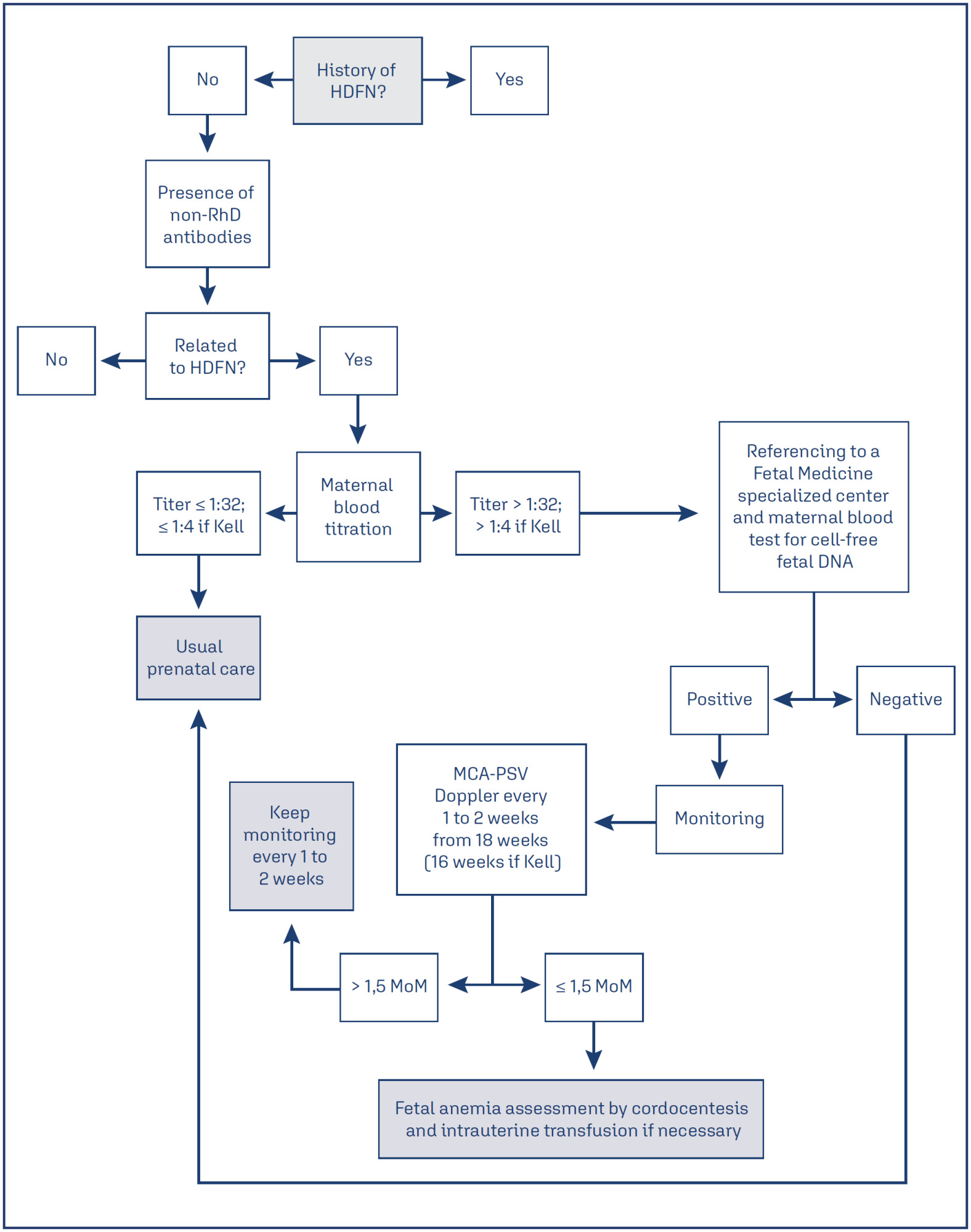
Summary
Rev Bras Ginecol Obstet. 2023;45(2):059-064
To evaluate the seroprevalence of toxoplasmosis among puerperal women cared for at a tertiary university hospital and the level of understanding of these puerperal women about toxoplasmosis, vertical transmission, and its prophylaxis.
For this cross-sectional study, we evaluated 225 patients using presential interviews, prenatal documentation, and electronic medical records. Data were stored using Research Electronic Data Capture (REDCap) software. Prevalence rates were estimated by the presence of reactive IgG antibodies against Toxoplasma gondii. Data analysis was performed using the chi-square test and calculation of the odds ratio (OR). Seroreactivity to T. gondii and exposure variables (age, educational level, and parity) were analyzed using a confidence interval (95%CI) and a significance level of 5% (p < 0.05).
The seropositivity rate for T. gondii was 40%. There was no association between seroprevalence and age. Primiparity was a protective factor against seropositivity and low education was a risk factor.
Knowledge of T. gondii infection and its transmission forms was significantly limited, presenting a risk for acute maternal toxoplasmosis and vertical transmission of this protozoan. Increasing the education level regarding the risk of toxoplasmosis during pregnancy could reduce the rates of infection and vertical transmission of this parasite.
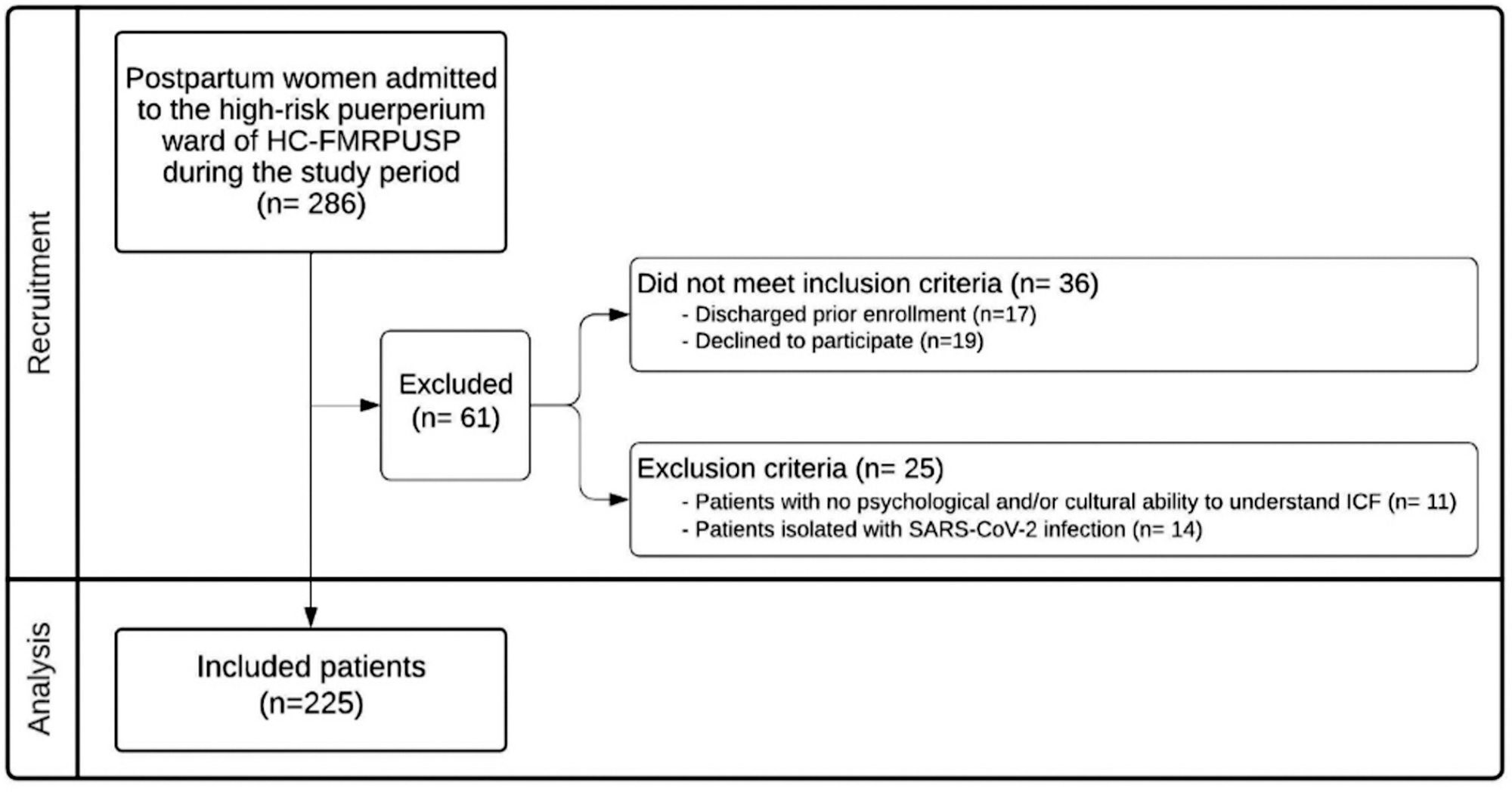
Summary
Rev Bras Ginecol Obstet. 2020;42(11):690-696
To evaluate the prevalence of hypertensive disorders, perinatal outcomes (preterm infants, low birthweight infants and Apgar score < 7 at the 5th minute and fetal deaths) and the cesarean rates in pregnant women hospitalized for delivery at the Maternidade Hilda Brandão da Santa Casa de Belo Horizonte, Belo Horizonte, state of Minas Gerais, Brazil, from March 1, 2008 to February 28, 2018.
A case-control study was performed, and the groups selected for comparison were those of pregnant women with and without hypertensive disorders. Out of the 36,724 women, 4,464 were diagnosed with hypertensive disorders and 32,260 did not present hypertensive disorders
The prevalence of hypertensive disorders was 12.16%; the perinatal outcomes and cesarean rates between the 2 groups with and without hypertensive disorders were: preterm infants (21.70% versus 9.66%, odds ratio [OR] 2.59, 95% confidence interval [CI], 2.40-2.80, p < 0.001); low birthweight infants (24.48% versus 10.56%; OR 2.75; 95% CI, 2.55-2.96; p < 0.001); Apgar score < 7 at the 5th minute (1.40% versus 1.10%; OR 1.27; 95% CI, 0.97-1.67; p = 0.84); dead fetuses diagnosed prior to delivery (1.90% versus 0.91%; OR 2.12; 95% CI, 1.67-2.70; p < 0.001); cesarean rates (60.22% versus 31.21%; OR 3.34; 95% CI, 3.14-3.55; p < 0.001).
Hypertensive disorders are associated with higher rates of cesarean deliveries and higher risk of preterm infants, low birthweight infants and a higher risk of fetal deaths.
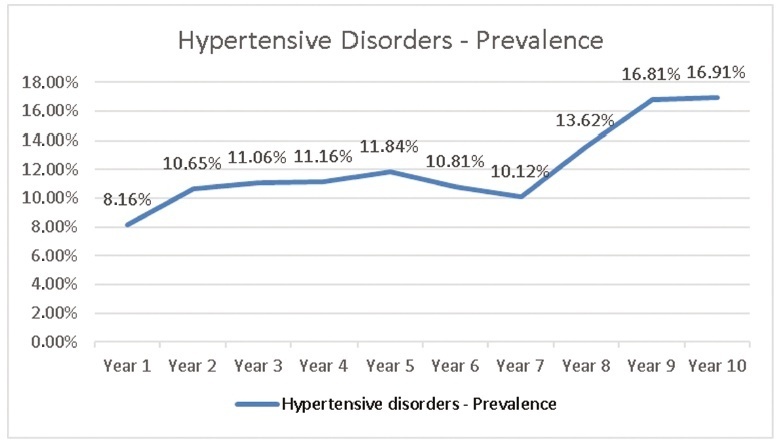
Summary
Rev Bras Ginecol Obstet. 2020;42(1):12-18
To assess the prevalence of gestational diabetes mellitus and the main associated risk factors in the population served by the Brazilian Unified Health System in the city of Caxias do Sul, state of Rio Grande do Sul.
A descriptive, cross-sectional and retrospective study was conducted. Maternal variables were collected from the medical records of all pregnant women treated at the basic health units in 2016. Hyperglycemia during pregnancy (pregestational diabetes, overt diabetes and gestational diabetes mellitus) was identified by analyzing the results of a 75-g oral glucose tolerance test, as recommended by the Brazilian Ministry of Health. Based on the data, the women were allocated into two groups: the gestational diabetes group and the no gestational diabetes group.
The estimated prevalence of gestational diabetes among 2,313 pregnant women was of 5.4% (95% confidence interval [95%CI]: 4.56-6.45). Pregnant women with 3 or more pregnancies had twice the odds of having gestational diabetes compared with primiparous women (odds ratio [OR]=2.19; 95%CI: 1.42-3.37; p<0.001). Pregnant women aged 35 years or older had three times the odds of having gestational diabetes when compared with younger women (OR=3.01; 95%CI: 1.97-4.61; p<0.001). Overweight pregnant women were 84% more likely to develop gestational diabetes than those with a body mass index lower than 25 kg/m2 (OR =1.84; 95%CI: 1.25-2.71; p=0.002). A multivariable regression analysis showed that being overweight and being 35 years old or older were independent variables.
In this population, the prevalence of gestational diabetes mellitus was of 5.4%. Age and being overweight were predictive factors for gestational diabetes.

Summary
Rev Bras Ginecol Obstet. 2019;41(9):555-563
To determine the prevalence of sexual dysfunction and its associated factors in pregnant women.
A descriptive, cross-sectional study including 262 pregnant women aged 18 years or older with gestational age between 10 and 35 weeks. Women with urinary tract infections and conditions of gestational risk were excluded. The Pregnancy Sexual Response Inventory (PSRI) questionnaire was used. We performed a univariate descriptive analysis, and comparisons between the mean values of the sexual function domains were made using the Student t-test. The chi-squared test was used to determine the association between the independent and dependent variables. The prevalence ratios, with their respective 95% confidence intervals, were also estimated, and a multivariate analysis was performed.
A total of 64.9% of women reported a decrease in the frequency of sexual activity during pregnancy. Slightly more than half of the women (50.8%) were satisfied, and arousal was reported as excellent/good by 30.5% of them. The frequency of sexual difficulties/dysfunctions increased with pregnancy, rising from 5.7% to 58.8%, and pain during sexual intercourse was reported by 45.8% of them. Having higher education degree decreased the chance of being sexually dissatisfied by 50%. The total PSRI score showed a significant decrease from the prepregnancy period (mean score = 89.8, “excellent”) to the pregnancy period (mean score = 59.2, “good”).
The mean sexual function score during pregnancy was classified as good, although most pregnant women reported at least one type of alteration in the sexual function domains, and the report of dissatisfaction was more frequent in women with lower schooling.
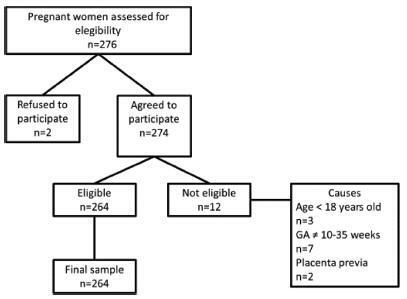
Summary
Rev Bras Ginecol Obstet. 2019;41(3):155-163
To evaluate the clinical epidemiological state of women with suspected post partum depression (PPD) in a public maternity hospital in Salvador, state of Bahia, Brazil.
A cross-sectional research was performed with puerperal patients attended at a public maternity hospital in Salvador, Bahia. Data collection was performed from June to September 2017. The Edinburgh Postnatal Depression Scale was used as a screening instrument, and, subsequently, women with positive scores answered a questionnaire to identify their clinical and epidemiological status.
Out of 151 postpartum women from the research, 30 (19.8%) presented suspicion of PPD. There was a prevalence of single mothers 13 (43.3%), women with complete fundamental education 15 (50.0%), women with black skin color 14 (46.7%), and those with a monthly family income of up to one minimum wage 18 (40.0%).
Although PPD is an underdiagnosed disease, a high prevalence of the condition was found in our research. It is, then, considered that these results reinforce its significance as a public health problem, requiring prevention strategies, early diagnosis and effective treatment.
Summary
Rev Bras Ginecol Obstet. 2017;39(8):376-383
To describe the trends in the prevalence of macrosomia (birth weight ± 4,000 g) according to gestational age in Brazil in the periods of 2001-2010 and 2012-2014.
Ecological study with data from the Brazilian Live Birth Information System (SINASC, in the Portuguese acronym) regarding singleton live newborns born from 22 gestational weeks. The trends in Brazil as a whole and in each of its five regions were analyzed according to preterm (22-36 gestational weeks) and term (37-42 gestational weeks) strata. Annual Percent Changes (APCs) based on the Prais-Winsten method and their respective 95% confidence intervals (CIs) were used to verify statistically significant changes in 2001-2010.
In Brazil, the prevalence of macrosomic births was of 5.3% (2001-2010) and 5.1% (2012-2014). The rates were systematically higher in the North and Northeast Regions both in the preterm and in term strata. In the preterm stratum, the North Region presented the highest variation in the prevalence of macrosomia (+137.5%) when comparing 2001 (0.8%) to 2010 (1.9%). In the term stratum, downward trends were observed in Brazil as a whole and in every region. The trends for 2012-2014 were more heterogeneous, with the prevalence systematically higher than that observed for 2001-2010. The APC in the preterm stratum (2001-2010) showed a statistically significant trend change in the North (APC: 15.4%; 95%CI: 0.6-32.3) and South (APC: 13.5%; 95%CI: 4.8-22.9) regions. In the term stratum, the change occurred only in the North region (APC:-1.5%; 95%CI: -2.5--0.5).
The prevalence of macrosomic births in Brazil was higher than 5.0%. Macrosomia has potentially negative health implications for both children and adults, and deserves close attention in the public health agenda in Brazil, as well as further support for investigation and intervention.
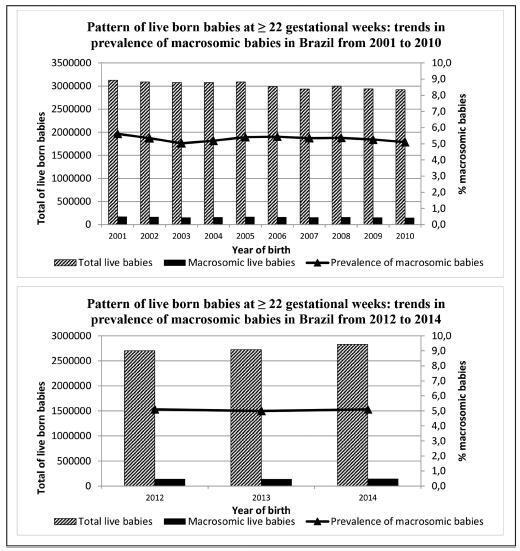
Summary
Rev Bras Ginecol Obstet. 2016;38(6):293-300
To assess the prevalence of depressive symptoms and their association with social, psychological, behavioral and obstetric characteristics in pregnant women.
This is a cross-sectional study. The sample consisted of 375 pregnant women who attended prenatal clinics in two public maternity hospitals located in the city of Goiania, Brazil. To testify the depressive symptoms, we used the Hospital Anxiety and Depression Scale (HADS). A descriptive statistical analysis was performed using programs such as CDC EPI-INFO(tm), version 7.1.5, and Statistical Package for Social Sciences (IBM SPSS), version 21.0.
the patients had probable depressive symptoms (15.47%) and possible depressive symptoms (25.33%). The bivariate analysis showed a significant association among "depressive symptoms" and the following variables: "single or divorced" (prevalence ratio, PR = 2.08; 95% confidence interval, CI = 1.26 to 3.44); "physical activity during pregnancy" (PR = 3.96; 95%CI = 1.28 to 12.31); exposure to "psychological/emotional" violence (PR = 4.74; 95%CI = 2.94 to 7.64); "prior mental problem" (PR = 2.66; 95%CI =1.49 to 4.73) and "obstetric complications during pregnancy" (PR = 2.53; 95%CI = 1.55 to 4.13). The multivariate analysis confirmed the association of these depressive symptoms with the variables "suffered psychological/emotional violence" (odds ratio, OR = 5.821; 95%CI = 2.939 to 11.528); "physical activity during pregnancy" (OR = 3.885; 95%CI = 1.060 to 14.231); "obstetric complications during pregnancy" (OR = 2.442; 95%CI = 1.233 to 4.834) and "single or divorced" (OR = 2.943; 95%CI = 1.326 to 6.533).
the prevalence of depressive symptoms among pregnant women is of 15.47%, and emotional violence is the main factor associated with gestational depression.
Search
Search in:
breast (42) breast cancer (42) breast neoplasms (95) Cesarean section (72) endometriosis (66) infertility (56) Maternal mortality (43) menopause (82) obesity (58) postpartum period (40) pregnancy (225) Pregnancy complications (99) Prenatal care (68) prenatal diagnosis (50) Prevalence (41) Quality of life (51) risk factors (94) ultrasonography (79) urinary incontinence (40) women's health (48)